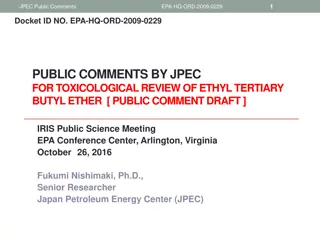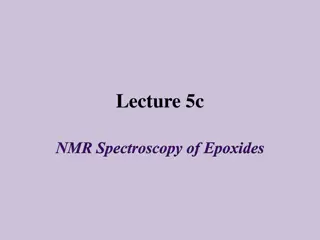
Ethers and Epoxides
Explore the world of ethers and epoxides in organic chemistry, including their structures, nomenclature, physical properties, preparation methods, and reactions. Learn about the common and IUPAC naming conventions, as well as the unique characteristics of ethers as polar molecules with distinct properties. Discover the significance of these organic compounds and their applications in various chemical reactions.
Download Presentation

Please find below an Image/Link to download the presentation.
The content on the website is provided AS IS for your information and personal use only. It may not be sold, licensed, or shared on other websites without obtaining consent from the author. If you encounter any issues during the download, it is possible that the publisher has removed the file from their server.
You are allowed to download the files provided on this website for personal or commercial use, subject to the condition that they are used lawfully. All files are the property of their respective owners.
The content on the website is provided AS IS for your information and personal use only. It may not be sold, licensed, or shared on other websites without obtaining consent from the author.
E N D
Presentation Transcript
Ethers and Epoxides 1 340 Chem 1st 1439
Outline 2 Structure of Ethers Nomenclature of Ethers Physical Properties of Ethers Preparation of Ethers Reactions of Ethers Epoxides: Structure and Nomenclature Synthesis of Epoxides Reactions of Epoxides 340 Chem 1st 1439
Ethers 3 Ethers are also organic relatives of water, where alkyl groups replace both hydrogen atoms. Thus, ethers have two hydrocarbons bonded to an oxygen atom. Ethers have the general formula R-O-R or R-O-R`, where R may be an alkyl (or phenyl) group different from R`. In a symmetrical ether , the alkyl substituents are identical. In an unsymmetrical ether , the alkyl substituents are different. The simplest and most common ethers are diethyl ether and tetrahydrofuran (THF), which is a cyclic ether. 340 Chem 1st 1439
Nomenclature of ethers 4 The common name of an ether consists of the names of the two alkyl substituents (in alphabetical order), followed by the word ether. The smallest ethers are almost always named by their common names. CH3O CH2CH3 Ethyl m ethyl ether CH3CH2O CH2CH3 Diethyl ether O Cyclohexyl isopentyl ether CH3 CH3 CH3CH O C HCH2CH3 CH3CHCH2O C CH3 CH3 CH3 CH3 sec-Butyl isopropyl ether tert-Butyl isobutyl ether 340 Chem 1st 1439
The IUPAC system names an ether as an alkane with an RO substituent. The substituents are named by replacing the yl ending in the name of the alkyl substituent with oxy. rootname alkoxy group 5 CH3 O CH2 CH2 CH3 CH3 CH3O CH3CHO CH3CH2O OCHCH2CH3 OCCH3 CH3 CH3 CH3 tert-butoxy methoxy ethoxy sec-butoxy isopropoxy O O O O O 1-Butoxy-2,3-dimethyl-pentane 2-Methoxy-butane 1,4-Diisopropoxy-butane 1-Ethoxy-3-methyl-pentane 340 Chem 1st 1439
H3 C 6 CH3 O CH3 O O H3 C CH3 H3 C CH3 3-Methoxyhexane 5-Ethoxy-2-heptene Propenoxy-benzene m-Dimethoxybenzene 1,3-Dimethoxybenzene Diphenyl ether Phenoxybenzene Common : Methyl Phenyl ether (anisole) IUPAC : Methoxy benzene 340 Chem 1st 1439
Physical properties of ethers 7 Ethers are polar molecules in which oxygen bears a partial negative charge and each attached carbon bears a partial positive charge. However, only weak dipole-dipole interactions exist between ether molecules in the liquid state. The boiling points of ethers are much lower than those of alcohols of comparable molecular weight and are close to those of hydrocarbons of comparable molecular weight 340 Chem 1st 1439
Because ethers cannot act as hydrogen bond donors, they are much less soluble in water than alcohols. However, they can act as hydrogen bond acceptors, which makes them more water-soluble than hydrocarbons of comparable molecular weight and shape. 8 For example, diethyl ether and THF are common solvents used in the Grignard reaction. Ethers often form complexes with molecules that have vacant orbitals, e.g. THF complexes with borane (BH3.THF), which is used in the hydroboration oxidation reaction . Ethers can form hydrogen bonds with water molecules 340 Chem 1st 1439
9 340 Chem 1st 1439
PREPARATION OF ETHERS Dehydration of Alcohols 10 In general, this method is limited to the preparation of symmetrical ethers in which both alkyl groups are primary alcohols and H2SO4. H+ R O + O R H H R O R + H2O heat 340 Chem 1st 1439
11 340 Chem 1st 1439
The Williamson Synthesis of Ethers 12 Nucleophilic substitution of an alkyl halide by an alkoxide or phenoxide gives the carbon oxygen bond of an ether. Methyl halides and primary alkyl halides are the best substrates. 340 Chem 1st 1439
13 340 Chem 1st 1439
Alkoxymercuration-Demercuration alkoxymercuration reduction 14 The reaction of an alkene with an alcohol in the presence of a mercury salt such as mercuric acetate Hg(OAc)2 or mercuric trifluoroacetate Hg(O2CCF3)2, in alcohol leads to an alkoxymercury intermediate, which on reaction with sodium borohydride NaBH4 yields an ether. When the alcohol reactant is also the solvent, the method is called solvomercuration demercuration. 340 Chem 1st 1439
15 340 Chem 1st 1439
Alkylation of Alcohols 16 A tert-butyl ether can be used to protect the hydroxyl group of a primary alcohol while another reaction is carried out on some other part of the molecule. A tert-butyl protecting group can be removed easily by treating the ether with dilute aqueous acid. 340 Chem 1st 1439
Reactions of Ethers Cleavage of Ethers 17 Ethers are cleaved by heating with HBr or HI to give alkyl bromides or alkyl iodides. Ethers are unreactive toward most bases, but they can react under acidic conditions. 340 Chem 1st 1439
18 340 Chem 1st 1439
Epoxides 19 Three-membered cyclic ethers are known as epoxides. Cyclic ethers have their oxygen as part of a ring they are heterocyclic compounds Cyclic ethers can be named in several ways. One simple way is to use replacement nomenclature, in which we relate the cyclic ether to the corresponding hydrocarbon ring system and use the prefix oxa- to indicate that an oxygen atom replaces a CH2 group (common name). The IUPAC rules also permit oxirane (without substituents) to be called ethylene oxide. Tetrahydrofuran and tetrahydropyran are acceptable synonyms for oxolane and oxane, respectively. In each case the ring is numbered starting at the oxygen. O O O O IUPAC name Common name O xeta ne O xan e (T etrah ydro pyra n) O xirane (E thylen e o xide ) Oxacyclopropane O xolan e (T etrahydrofu ran) Oxacyclopentane THF Oxacyclobutane 340 Chem 1st 1439
20 O oxirane 1,2-epoxyethane 18-Crown-6 [C2H4O]6 IUPAC name 1,4,7,10,13,16-hexaoxa- cyclooctadecane Dioxane Furan 1,4-Dioxacyclohexane One systematic method for naming epoxides is to name the rest of the molecule and use the term epoxy as a substituent, giving the numbers of the two carbon atoms bonded to the epoxide oxygen. H O 1 O H O 3 2 O CH3 H trans-1,2-epoxy-4-methylcyclohexane 2,2-diethyl-3-isopropyloxirane 3,4-epoxy-4-ethyl-2-methylhexane trans-2-methoxy-3-methyloxirane 1,2-epoxy-1-methoxypropane 340 Chem 1st 1439
Synthesis of Epoxides Oxidation of Alkenes with Peroxycarboxylic Acids 21 The most common laboratory method for the synthesis of epoxides from alkenes is oxidation with a peroxycarboxylic acid (a peracid). Three of the most widely used peroxyacids are meta-chloroperoxybenzoic acid (MCPBA), the magnesium salt of monoperoxyphthalic acid (MMPP), and peroxyacetic acid. 340 Chem 1st 1439
Internal Nucleophilic Substitution in Halohydrins 22 treating the alkene with chlorine or bromine in water to form a chlorohydrin (or bromohydrin) followed by treating the halohydrin with a base (NaOH, NaOEt,..) to bring about intramolecular displacement of Cl. 340 Chem 1st 1439
Reactions of Epoxides 23 Epoxides react rapidly with nucleophiles under conditions in which other ethers are inert. This enhanced reactivity results from the ring strain of epoxides. Reactions that lead to ring opening relieve this strain. 340 Chem 1st 1439
1- Acid Catalyzed ring opening of epoxides in water to form glycols. O OH + 24 H3O CH CH R R R CH CH R OH 2- Acid Catalyzed ring opening of epoxides in alcohol to form alkoxy alcohols CH3 O O + .. H3O + CH CH R OH H3 C R CH CH R R OH 3- Acid Catalyzed ring opening of epoxides with a hydrohalic acid (HCl, HBr, or HI), a halide ion attacks the protonated epoxide to give halo alcohol . X O + CH CH R H X R CH CH R R 4- Ring opening of epoxides with amines OH NHCH3 O H3O+ CH3NH2 + R CH CH R R CH CH R 340 Chem 1st 1439 OH
5- Ring opening of epoxides with Grignard and Organolithium Reagents to give longer alcohols O + OH 1) ether 25 CH CH R R R' MgX R CH CH R 2) H3O+ R' or R' Li 6- Epoxides are reduced to alcohols on treatment with lithium aluminum hydride. Hydride is transferred to the less crowded carbon. 340 Chem 1st 1439
Orientation of Epoxide Ring Open 26 Symmetrically substituted epoxides (such as cyclopentene oxide, above) give the same product in both the acid-catalyzed and base-catalyzed ring openings. An unsymmetrical epoxide may produce different products under acid-catalyzed and base-catalyzed conditions. 340 Chem 1st 1439
27 340 Chem 1st 1439










